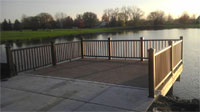Piers and Boardwalks in {{CITY}}, {{STATE}}
 Though most of our projects are entirely land–based, we at Community Renovations are also proud to offer our services in the building of piers, boardwalks and other maritime structures. We construct these items in strict concordance with the guidelines laid out by the Americans with Disabilities Act, or ADA. As a company with a great deal of experience creating barrier–free projects, Community Renovations is an ideal candidate for a venture as strictly regulated as the building of a pier and/or boardwalk. Back in 2002, representatives behind the ADA published what they called “accessibility guidelines,” or rules the builders of piers and boardwalks had to follow to make their creations fully handicap–accessible. These regulations must be carefully considered before the start of any similar building project, as these rules are, for all intents and purposes, dictated by law. Because of our commitment to assisting those with disabilities through a variety of methods, Community Renovations are an ideal company to build your pier and/or boardwalk and do so while strictly adhering to code.
Though most of our projects are entirely land–based, we at Community Renovations are also proud to offer our services in the building of piers, boardwalks and other maritime structures. We construct these items in strict concordance with the guidelines laid out by the Americans with Disabilities Act, or ADA. As a company with a great deal of experience creating barrier–free projects, Community Renovations is an ideal candidate for a venture as strictly regulated as the building of a pier and/or boardwalk. Back in 2002, representatives behind the ADA published what they called “accessibility guidelines,” or rules the builders of piers and boardwalks had to follow to make their creations fully handicap–accessible. These regulations must be carefully considered before the start of any similar building project, as these rules are, for all intents and purposes, dictated by law. Because of our commitment to assisting those with disabilities through a variety of methods, Community Renovations are an ideal company to build your pier and/or boardwalk and do so while strictly adhering to code.
What Are the ADA’s Guidelines for {{CITY}}?
The list of rules that all piers and boardwalks must follow to be classified as handicap accessible in the eyes of ADA representatives is long and complex. While not every rule will be described here, a token few will be mentioned as examples.
- At least one handicap–accessible route must connect all the buildings located on a particular boardwalk or pier. This route has strict regulations based on width, head room and slope and a wide variety of other considerations.
- The length of gangways must correspond to their distance from water level. Those with a rise of over six–inches must have handrail extensions of a specific diameter and height.
- If a pier or platform is to contain a railing must correspond to specific heights: 34 inches or fewer unless the pier or boardwalk is located in an area which requires augmented safety measures.
- Some type of safe barrier must be located in areas meant for fishing. This way, disabled fishermen can utilize various areas on the pier or boardwalk for the purpose of angling. One option is the building of the aforementioned railing, but one could also install handrails or guards.
- There must be at least one completely clear area (30 by 48 inches minimum) on every pier or platform.
- Piers and platforms must contain a clearly–defined and easily accessible turning area.
In the end, the regulations set out by the ADA are highly complex, and to ensure that your pier or boardwalk in {{CITY}}, {{STATE}} is up to code you’ll need a company with a great deal of experience, one who knows much about barrier–free, handicap–friendly design. For this reason, consider Community Renovations. We’ll ensure that your pier or boardwalk is ideally constructed from beginning to end.